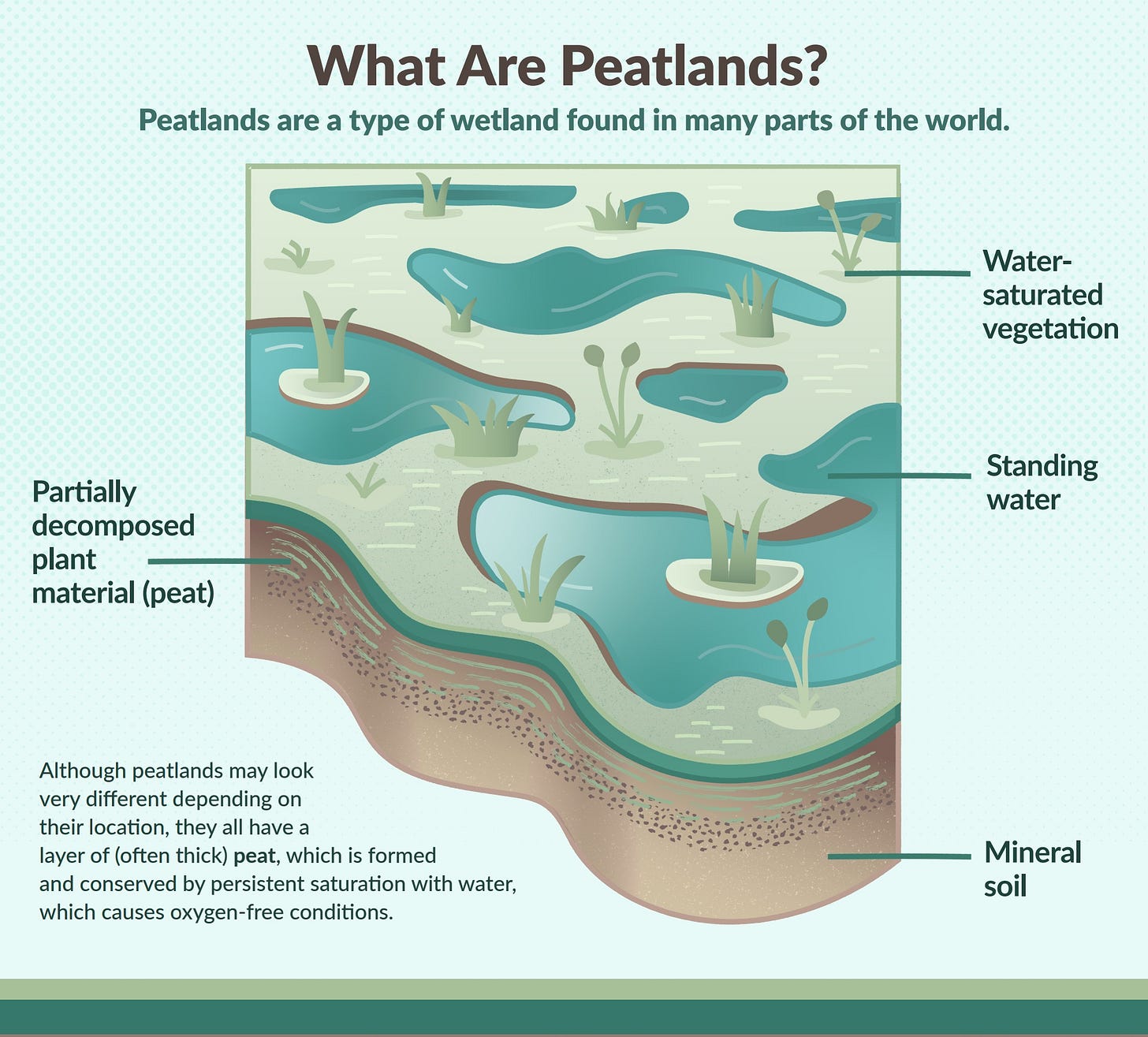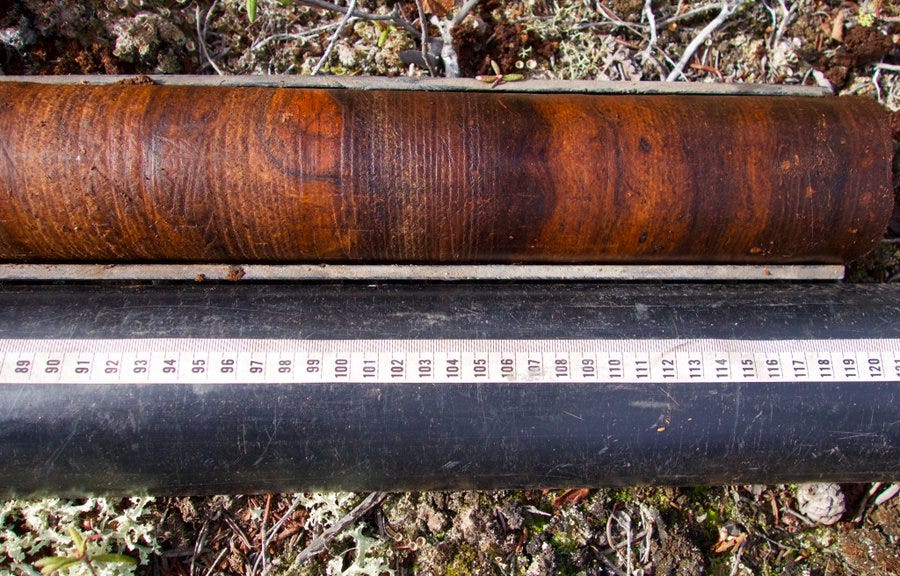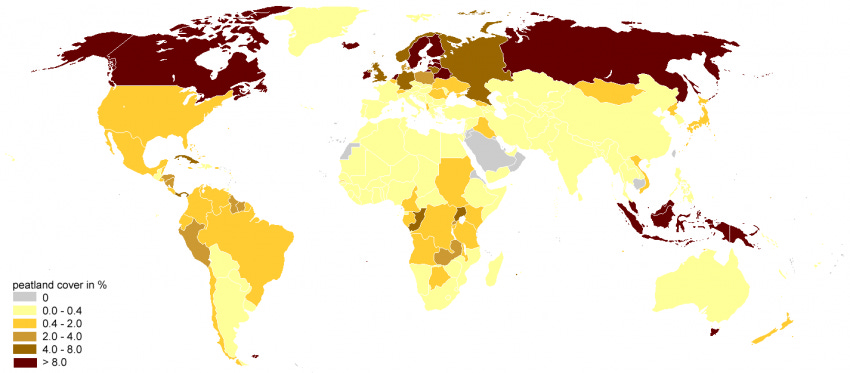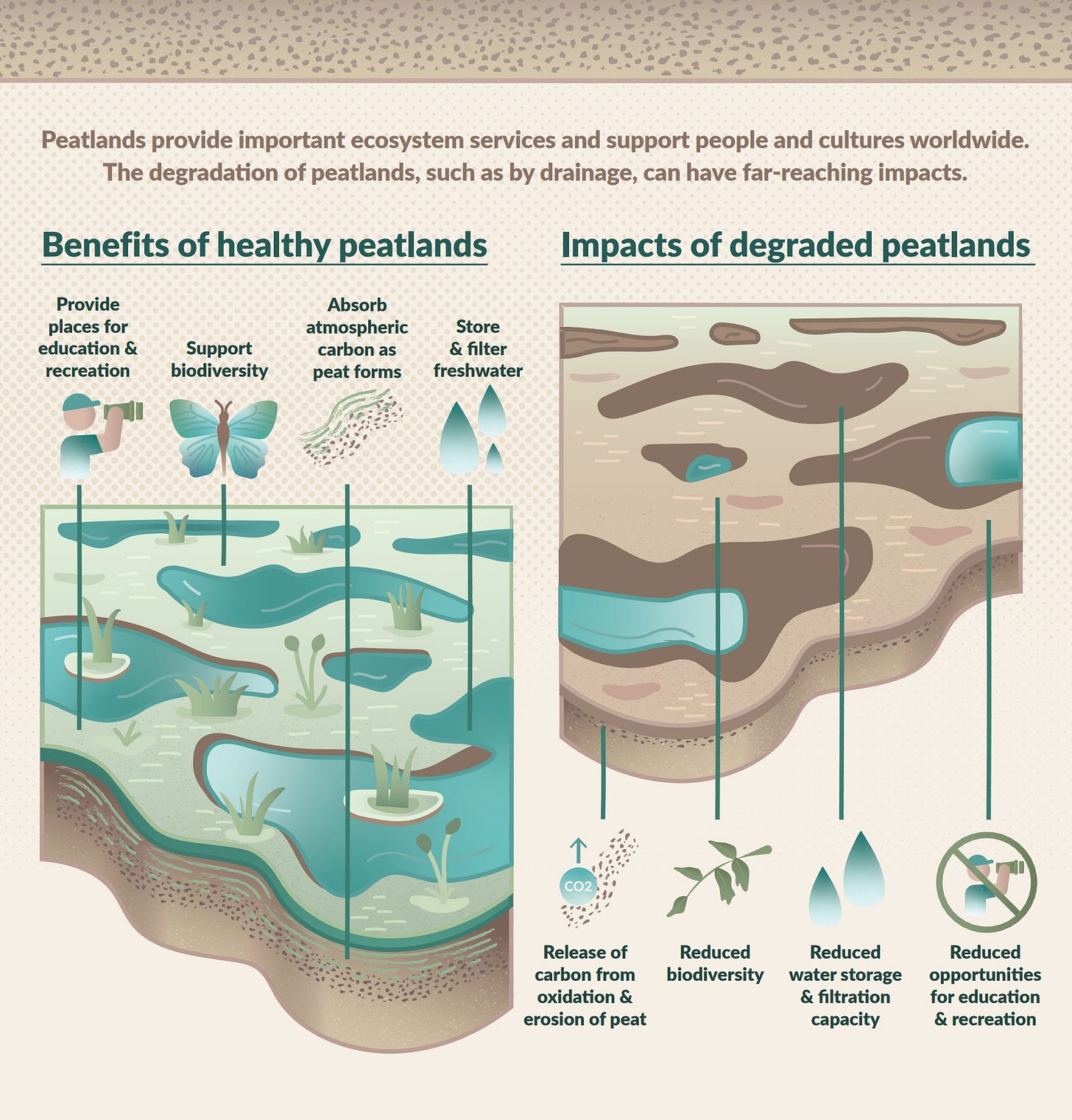peatlands are the 🐐
2500 GT of carbon is stored in our soils. 44% of soil carbon is in peatlands. Let that sink in.
Another Sunday, another morning spent thinking about our global carbon cycle. I’ve written about natural climate solutions previously. I’m continuing to explore the many ways our ecosystems make us more resilient to climate change.
An underrated ecosystem imho? Peatlands.
Peatlands cover just 3% of Earth’s surface but store 44% of all soil carbon in the world. The world's largest terrestrial carbon stock – storing at least 550 GT of carbon globally – more than twice the carbon stored in all the world's forests.
I thought these numbers were pretty unbelievable. How is it that 3% of our landscapes are carrying climate regulation and our carbon cycles on their backs?
What even is peat
Peat is like soil in beast mode. Peat itself is accumulated organic matter that is saturated by water. Permafrost is a layer of permanently frozen soil or rock found in very cold regions.

In the image below, 3000-4000 years of history is represented. 50% of this type of frozen peat is solid carbon.

As we think about how best to maintain climate stability and balance our carbon cycle, we’d do well to give some love to our peatlands.
Peatlands are the 🐐
Peatlands can help mitigate wildfires and flooding, acting as sponges that absorb and intelligently release moisture to the ecosystem, as all wetlands do. One of the first fields trips I took in my geography class was to the Oak Ridge Morraine an hour from Toronto. We spent the day out in nature learning about geological formations, and the importance of wetlands and watersheds. Watersheds are areas of land that channel water, from rainfall or snowmelt, into a marsh, stream, river, lake, or groundwater. Upland peatlands’ ability to store water reduces the risk of flooding downstream. Given this ecosystem service, governments can pay a portion of the peatland restoration cost as they would need to invest less for flood protection.
Peat under fire: Ontario’s Ring of Fire
So where exactly are these peatlands that take up 3% of our landscapes? Peatlands are concentrated in boreal and temperate climates of Europe, Canada, and Russia. Tropical peatlands are also concentrated in Southeast Asia.

A concerning project that has come to my attention recently is the development of the Ontario, and area of the Hudson Bay Lowlands, for mining development. This hits close to home as it is a long drive North from my childhood home in Toronto. A square meter of Canadian peatlands holds 5X the carbon as a square meter of the Amazon rainforest. 13X the amount of global emissions in 2020 would be released as a result of peatland development in Ontario. Unfortunately, there is a tough tradeoff at hand. Rare earth materials reserves of nickel are also beneath the peat. We need critical materials for the energy transition. This is why I’m excited about companies like Lilac Solutions, who are extracting lithium from brines.
From carbon sink to source
If we are to stabilize our climate, we need to significantly reduce our emissions while protecting our natural carbon sinks and stores. Importantly, we should prevent our current carbon stores from becoming sources of emissions themselves. Which, unfortunately, many are.
Wet peatlands that are drained or frozen permafrost that has become to thaw represents huge sources of methane emissions. When exposed to oxygen, microbes in the soil are activated and begin to or more quickly decompose the organic matter. Basically, the soil organic matter begins to break down and is respired by the bacteria, released back in the atmosphere. This is why keeping peat wet or frozen ensures the stability of carbon stock is important.

How do we protect peatlands?
Public and private finance must be mobilised to help protect our peatlands. Possible instruments include emissions trading schemes and carbon markets, investment in restoration through payment for ecosystem services (such as clean water and flood protection), environmental bonds, or government-backed carbon price guarantees. Strategic actions outlined by the UENP and FAO include assessing the distribution and state of peatlands globally; measuring and reporting emissions from peatlands; protecting and restoring peatlands with targeted investments; stimulating market-based mechanisms to support peatlands; engaging and supporting local communities to manage peatlands sustainably and overcome associated costs; sharing expertise and experience on peatland conservation, restoration and improved management.
How can you learn more about peatlands? Glad you asked:
Pew Trusts. Peatlands, Which Can Help Fight Against Climate Change, Face Many Threats.
IUCN UK National Committee Peatland Programme,
IUCN. Global Peatland Restoration: Demonstrating Success
World Economic Forum. Peatlands worldwide are drying out, threatening to release 860 million tonnes of carbon dioxide every year.
Want more high-quality sources, takeaways, and summaries? Email daylightclimate@gmail.com. ☀️ Hope you have a great week!

